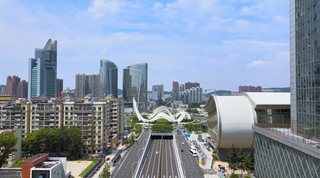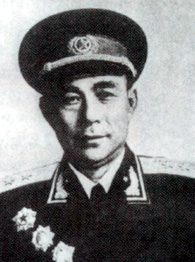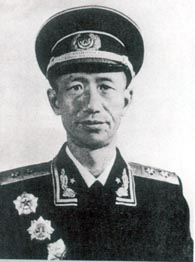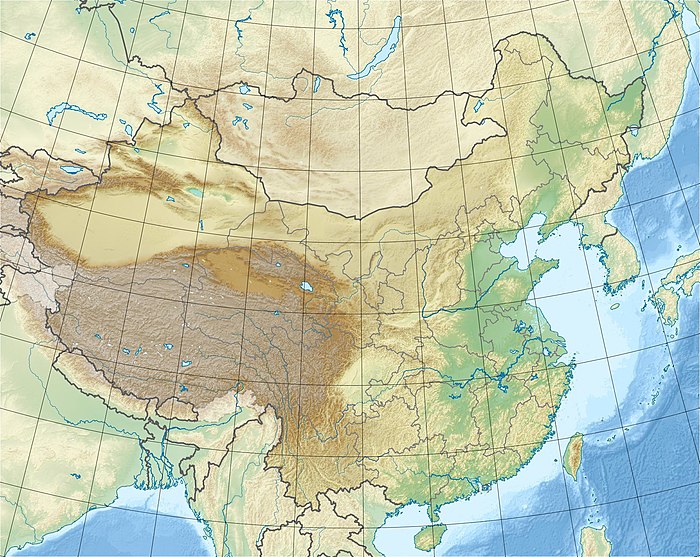
Qinghai, ching-HY, also known as Kokonor, is a landlocked province in the northwest of the People's Republic of China. It is the largest province of China by area and has the third smallest population. Its capital and largest city is Xining.

Dangyang is a city in western Hubei province, People's Republic of China, lying 70 kilometres (43 mi) east of the Gezhouba Dam on the Yangtze River. During the Western Han Dynasty. Emperor Jing of Han established an administration in Dangyang on an area of 2,000 square kilometres (770 sq mi). In 1988 the State Council of the People's Republic of China elevated this from a county to a county-level city, and is currently under the administration of the prefecture-level city of Yichang.

Golmud, also known by various other romanizations, is a county-level city in the Haixi Mongol and Tibetan Autonomous Prefecture of Qinghai Province, China. It is now the second-largest city in Qinghai and the third largest in the Tibetan Plateau. The population in 2020 is 221,863.

Tuanfeng County is a county under the administration of the prefecture-level city of Huanggang, in the east of Hubei province, situated on the north (left) bank of the Yangtze River. There is a famous high school, named Tuanfeng High School. It provides many good students to universities all over China.

Jiangxia District is one of 13 urban districts of the prefecture-level city of Wuhan, the capital of Hubei province, China, situated on the eastern (right) bank of the Yangtze River. Jiangxia district has an area of 2,009 square kilometres (776 sq mi) and a population of 680,000. It is the southernmost and most sparsely populated of Wuhan's districts. It borders the districts of Caidian and Hannan across the Yangtze and Hongshan to the north, as well as the prefecture-level cities of Ezhou to the east, Huangshi to the southeast, and Xianning to the south.

Ruoqiang County as the official romanized name, also transliterated from Uyghur as Qakilik County, is a county in the Xinjiang Uyghur Autonomous Region, China under the administration of the Bayingolin Mongol Autonomous Prefecture. It covers an area of 198,318 square kilometres (76,571 sq mi), making it the largest county-level division in the country.

Hotan County is a county in the southwest of the Xinjiang Uyghur Autonomous Region and is under the administration of the Hotan Prefecture. Almost all the residents of the county are Uyghurs and live around oases situated between the desolate Taklamakan Desert and Kunlun Mountains. Hotan County is the southernmost county-level division of Xinjiang. The county borders Karakax/Moyu County to the northwest, Hotan City and Lop County to the northeast, Qira County to the east, Pishan County to the west, and Rutog County, Tibet to the southeast. Hotan County administers most of Aksai Chin, an area disputed between China and India. The Line of Actual Control divides the India-controlled part of Ladakh union territory from the Aksai Chin area administered as part of southwest Hotan County.

Quanzhou Jinjiang International Airport is a dual-use military and public airport serving the city of Quanzhou in Fujian, China. It is located 12 kilometers south of the city center, in the county-level city of Jinjiang, which is under the administration of the prefecture-level city of Quanzhou.

Lanzhou Zhongchuan International Airport is an airport serving Lanzhou, the capital of Gansu Province, China. It is located 71 kilometres (44 mi) northwest of downtown Lanzhou. It was opened in 1970 and serves as a major air hub for the province of Gansu and western China. There are eight gates served by aerobridges in the terminal. A new larger Terminal 2 is located to the South, adjacent to the existing terminal. The new terminal adds nine aerobridges.

Zhuhai Jinwan Airport, also called Zhuhai Sanzao Airport before January 10, 2013, is the airport serving the city of Zhuhai in Guangdong province, China. It is located some 50 kilometres (31 mi) southwest of the Zhuhai city center in Sanzao Town, Jinwan District, and 25 kilometres (16 mi) southwest of the special administrative region of Macau.

Hongshan District forms part of the urban core of and is one of 13 urban districts of the prefecture-level city of Wuhan, the capital of Hubei Province, China. The district is named for Mount Hong, located near East Lake. It is the most populous of all the districts, and is the most spacious but least densely populated among the city's seven core districts.

Huangpi District is one of 13 urban districts of the prefecture-level city of Wuhan, the capital of Hubei Province, China, situated on the northern (left) bank of the Yangtze River. The Sheshui enters the Yangtze at Huangpi. The district is primarily rural, but also includes important infrastructure facilities, such as Wuhan Tianhe International Airport and Wuhan North Railway Station, which is one of the main freight stations and classification yards on the Beijing–Guangzhou Railway. It is the northernmost of Wuhan's districts as well as the most spacious. On the left bank of the Yangtze, it borders the districts of Xinzhou to the east, and Jiang'an to the south, and Dongxihu to the southwest; on the opposite bank, it borders Hongshan. It also borders the prefecture-level cities of Huanggang to the northeast and Xiaogan to the northwest. The Sheshui enters the Yangtze River at Shekou in Huangpi.
Liangzihu District is a district of the city of Ezhou, Hubei, People's Republic of China.
Shuangpai County is a county in Hunan Province, China, it is under the administration of the prefecture-level city of Yongzhou. Shuangpai is also the 3rd smallest administrative unit by population in the counties and county-level cities of the province.
Burqin Kanas Airport is an airport that serves Burqin County and the nearby tourist destination Kanas Lake in Xinjiang, China. It is located 50 kilometers south of the lake in Burqin County. The airport was constructed in 2006 and opened on 15 August 2007. Until 2019, the airport was only open for flights in the summer.
Longgan Lake is a freshwater lake in central China, divided between Susong County of Anhui Province and Huangmei County at the eastern extremity of Hubei Province. The lake is situated near the north bank of the middle reaches of Yangtze River, opposite Poyang Lake. The lake was named Longgan Lake in a 1955 decision which combined the names of two former lakes, Long Lake (龙湖) and Gan Lake (感湖).

Donghu New Technology Development Zone, also referred to as Optics Valley or Guanggu, is a New Technology Development Zone in Wuhan, China. It was established in 1988. In 1991 it was approved as one of the National Economic and Technological Development Zones of China. In 2011 it was designated as a New Technology Development Zone for Optical technology, and since then self-labeled as the "Optics Valley" of China.

Liu Fei was a People's Liberation Army lieutenant general. He was born in Hong'an County, Hubei Province. He was a platoon and then company commander in the Chinese Workers' and Peasants' Red Army before being a regimental commander in the New Fourth Army.

Zhou Xihan was a People's Liberation Army lieutenant general. He was born in Dawu County, Hubei. He served in the Chinese Workers' and Peasants' Red Army and Eighth Route Army. He fought in the Chinese Civil War and Second Sino-Japanese War.
Zhang Jixian is a Chinese pulmonologist. She is known to have discovered SARS‑CoV‑2, and was the director of the Department of Respiratory Medicine of Hubei Provincial Hospital of Integrated Chinese & Western Medicine. She is also a member of the Chinese Communist Party.















